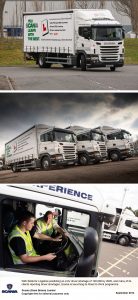With Skills for Logistics predicting an LGV driver shortage of 120,000 by 2020, and many of its clients reporting driver shortages, Scania is launching its Road to Work programme.
This new initiative has been designed to bring new drivers into the industry quickly and sustainably with the specialist skills required by their prospective employers. Where there are vacancies the scheme can also enable job seekers to acquire an LGV licence with funding support provided through existing government schemes. Additionally, Scania is working with industry partners to identify suitable employed candidates wishing to transfer from their existing roles to a new career behind the wheel.
“There’s no doubt that the UK is heading for a serious driver shortfall and that urgent action is required,” says Scania (Great Britain) Limited’s Driver Services Manager Mark Agnew. “Our response is Road to Work, which provides a route to LGV licence acquisition for job seekers or those in employment looking to progress themselves by developing news skills as a truck driver. Road to Work is a flexible programme that will also work for clients eager to bring apprentices into their business that ultimately end up with an LGV licence. More importantly Road to Work is a route to developing professional drivers who are ready for the workplace. This is much more than a licence acquisition course; it is bespoke to our clients needs.
“Our recruitment partners work with government agencies and appointed contractors to identify and assess potential candidates to ensure that the best people are selected. Those chosen are then trained to pass their Category C (rigid truck) licence by us. In the case of job seekers’ assessments, government backed schemes are in place to identify suitability and, in some circumstances, provide funding. Launched to over 300 customers in July, we are now working with several of these to implement Road to Work.”
Mark Agnew concludes that even without government funding, the business case for Road to Work is compelling, especially with the backdrop of a driver shortage, rising employment and agency costs. “It is not just people with licences the industry needs, but fuel-efficient and technologically-sound individuals who understand the product they are driving and their employer’s business,” he says. “The job of a driver really has changed, especially in the last five years, and is sure to do so again over the coming five.”





